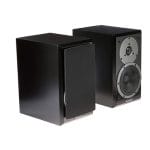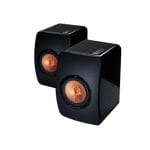In-Depth Comparison: Dynaudio Emit M10 vs. KEF LS50
After years of diving deeply into the HiFi and audio production world, I’ve had the pleasure of reviewing an array of acclaimed audio products. Today, I will compare two prominent bookshelf speakers: the Dynaudio Emit M10 and the KEF LS50. Both are highly respected in the audio community, but they bring unique traits and characteristics. Given their disparity in design, sound, and price points, it’s crucial to dissect them thoroughly so that potential buyers can make an informed decision.
Build Quality and Design
Starting with the build quality, the Dynaudio Emit M10 immediately sets a high standard. These speakers boast a solid design that easily mirrors the build quality of more premium units. Unlike many affordable models, the Emit M10 features a robust industrial pattern, setting it apart from its budget-friendly peers. The compact design makes it ideal for small to medium-sized rooms without compromising on visuals or durability.
On the other hand, the KEF LS50 shows off a unique UniQ driver along with an aesthetically pleasing design. The craftsmanship on these is evident, and even though they don’t support bi-wiring, they combine stylish accents with solid construction. Their sleek form factor can blend effortlessly with various room decors. Still, the limited color options might be a minor drawback for some users.
Sound Performance
When it comes to performance, both speakers present a compelling case, albeit with different strengths.
The Emit M10’s sound character leans towards a warm spectrum. With a detailed and accurate output, it’s versatile across different amplification sources. The soundstage is broad and deep, providing an immersive listening experience, especially when powered by a quality amplifier. However, the lack of punch in the low-end might be a letdown for fans of high-energy genres. Despite this, they are remarkably adaptable and can deliver smooth tonal balance and refined sound when properly powered and positioned.
Conversely, the KEF LS50 offers dynamic sound performance, characterized by precision, agility, and a wide soundstage. The treble is exceptional, and the midrange clarity is particularly note-worthy, making it a favorite for multiple music genres. The LS50’s transparency reveals the nuances of the audio chain, ensuring that you experience the music as intended by the recording engineer. However, the LS50’s lower bass extension might not satisfy those who prefer a robust low-frequency punch without a subwoofer.
Value for Money
Value is a significant consideration when evaluating any audio equipment. The Dynaudio Emit M10 offers excellent value for its price. Given its solid build, versatile sound performance, and the ability to improve with high-quality amplification, it provides a compelling entry into high-quality audio without a hefty price tag. However, it’s worth noting that achieving the best performance does require careful pairing with the right amplifier and setup.
On the other hand, the KEF LS50 is on a higher price spectrum, but its performance justifies the additional cost. The sheer clarity, detailed treble, and accurate midrange make it a worthwhile investment for serious audiophiles. While it is not a budget-friendly option, its price-to-performance ratio is impressive, presenting great sound quality that competes with even higher-end models.
Downsides and Considerations
No product is without its shortcomings, and understanding these helps set the right expectations.
For the Dynaudio Emit M10, the primary criticism lies in its bass response. While accurate, it lacks the vigorous punch needed for more energetic music genres. Users may need a subwoofer to compensate if they desire more impactful bass. Additionally, the Emit M10s show optimal performance with quality amplification and careful positioning, which might be a bit demanding for a casual user.
The KEF LS50, while celebrated for its quality, does have some limitations. The scarcity of color and finish options might not suit everyone’s aesthetic preferences. Additionally, the LS50’s bass, though sufficient, may not fully satisfy bass enthusiasts without additional support from a subwoofer. The need for meticulous placement can also be a slight inconvenience for users looking for straightforward setup and use.
Final Thoughts
Both the Dynaudio Emit M10 and KEF LS50 have earned their spots in the HiFi world for good reasons. The Emit M10 impresses with its robust build and adaptable sound, making it an excellent choice for those seeking quality without an overwhelming investment. On the flip side, the KEF LS50 shines with its precise and detailed sound, offering a higher-tier experience that justifies its cost.
Ultimately, the choice between these two depends on individual needs and preferences. If budget constraints are significant, or if you’re starting your journey into high-quality audio, the Dynaudio Emit M10 stands as a solid choice. For those willing to spend a little extra for intricate sound details and higher-end performance, the KEF LS50 is an exceptional candidate.
Comparing Aspects
User-Based Scores & Our Experts Analysis
KEF LS50
Dynaudio Emit M10
The KEF LS50, meanwhile, provides a sufficient and accurate low-frequency response suitable for most listening experiences. Still, those requiring an earth-shaking bass might find it slightly lacking, often needing a subwoofer to fulfill those extra low-frequency needs. The LS50’s bass response is more refined, favoring accuracy over power, which may appeal more to purists focused on nuanced performances. Aspect Verdict: Both speakers have their strengths: the Dynaudio Emit M10 in delivering tight, controlled bass and the KEF LS50 in providing accurate yet modest low-frequency response. For those who prioritize refined control, the Emit M10 has an edge, while the KEF LS50 would better serve those looking for an overall more accurate and balanced bass.
The KEF LS50, however, excels in delivering sharp and transparent treble. Its higher-frequency range is crystal clear and precise, revealing minute details within any musical track. This trait is particularly beneficial for genres requiring pronounced treble clarity, such as classical or jazz music. Aspect Verdict: When it comes to treble detail, the KEF LS50 has a distinctive advantage due to its sharp, clear, and highly detailed upper frequencies. The Dynaudio Emit M10, while delivering an excellent treble performance, does not reach the exceptional clarity level that the LS50 provides.
The KEF LS50 matches and arguably surpasses the M10 in this area, offering depth and clarity that produce a lifelike quality in vocals and instruments. This vivid midrange presence allows listeners to feel as if they are in the same room as the performers, creating an engaging and intimate auditory experience. Aspect Verdict: Both speakers showcase their strengths in midrange clarity, but the KEF LS50 takes a slight lead due to its superior depth and lifelike quality in reproducing midrange frequencies. It’s a fantastic choice for listeners who prioritize clear and engaging vocal and instrumental presentation.
The KEF LS50, however, shines with its unique UniQ driver array and stylish attributes. Despite its limited color choices, the LS50's design effortlessly complements room decor, adding a touch of modern charm with its sleek form factor. Although it doesn’t support bi-wiring, the design and aesthetics provide a luxurious feel unmatched in its category. Aspect Verdict: In terms of design and aesthetics, the KEF LS50 holds a noticeable edge. Its modern and refined look, paired with unique design elements, makes it stand out as the more stylish option, whereas the Dynaudio Emit M10, despite being appealing and sturdy, has a more traditional appearance.
The KEF LS50’s sound quality is stellar, characterized by a combination of playful musicality and precise accuracy. The wide soundstage and clear treble make every listening session an immersive experience. The transparency of the LS50 allows listeners to discern minute details and subtleties in each track, making it an audiophile favorite. Aspect Verdict: While both speakers offer remarkable sound quality, the KEF LS50 surpasses with its pristine clarity, wide soundstage, and detailed articulation. It is a more nuanced and revealing speaker, ideal for serious audiophiles who crave precision and depth in their audio experience. The Dynaudio Emit M10, while exceptional in its own right, excels more-so in versatility and balanced performance across various genres.
The KEF LS50, though pricier, offers sound quality and performance that rival much more expensive speakers. Its ability to reveal minute details in music tracks and its overall musicality provide a compelling case for its higher price tag. It’s a solid investment for those willing to spend a bit more for state-of-the-art performance. Aspect Verdict: While the Dynaudio Emit M10 provides superb value for those entering the world of high-quality audio, the KEF LS50 offers exceptional performance that competes with high-end models, making it a worthwhile investment for dedicated audiophiles. Their respective value metrics depend significantly on the buyers’ budget and desired performance levels.
Final Verdict
The Dynaudio Emit M10 and KEF LS50 both offer unique strengths and cater to different audio preferences. The Emit M10 features solid build quality, versatile sound, and excellent bang-for-the-buck value, making it an excellent option for those starting their journey into high-fidelity audio. Its performance scales well with quality amplification and room setup, offering balanced sound quality that appeals broadly.
The KEF LS50 commands a higher price but brings with it exceptional sound quality marked by precise treble, clear midrange, and a wide soundstage. Its transparency and agility in revealing the finer nuances of audio tracks make it a stellar choice for serious audiophiles. Though limited in color options and requiring careful placement, the LS50’s striking design and aesthetic appeal set it apart.
Choosing between these two comes down to budget and specific audio needs. For those seeking a cost-effective, highly capable speaker, the Dynaudio Emit M10 is the way to go, while audiophiles willing to invest in top-notch quality will find the KEF LS50 a worthy addition to their collection.
Comparison and Difference Between
Use dropdown menus to compare different models.
| Compare Speakers |
Brand and Model Specifications
Information about the brand, model release date.
| Manufacturer | Dynaudio | KEF |
| Model | Emit M10 | LS50 |
| Photo |  |
 |
| Release Date | 2017 | 2013 |
| HifiSpecs Rating | ||
| Amazon Rating | ||
| Price |
Technical Specs
Technical characteristics of the speakers.
| Amplification Type | Passive | Passive |
| Crossover Type | 2-Way | 2-Way |
| Enclosure type | Bass Reflex | Bass Reflex |
| Frequency Range (+/-3 dB)[Hz] | 50 - 23000 | 79 - 28000 |
| Frequency Range (-6dB)[Hz] | - | 47 - 45000 |
| Maximum SPL [dB] | - | - |
| Sensitivity (2,83 V/1 m)[dB] | 86 | 85 |
| Nominal Impedance (Ohms) | 6 | 8 |
| THD (Total Harmonic Distortion) | - | - |
| Recommended Amplifier Power [W] | - | 25-100 |
| Crossover Frequency [Hz] | 1800 | 2200 |
| Bass Reflex Tuning Frequency [Hz] | - | - |
| Driver Units | Tweeter: 28mm soft dome |
Tweeter: Uni-Q driver array with 1″ (25mm) vented aluminum-dome tweeter |
| Connectivity | Wired | Wired |
| Inputs | Single Wire | Single Wire |
| Outputs | - | - |
| Magnetic Shielding | No | No |
Placements and Distances
Where and how to put them.
| Form Factor | Shelf, Stand | Shelf, Stand |
| Distance from Wall [cm] | 15 | 15 |
Dimensions and Weight
Physical characteristics of the speakers (without stands).
| Length | ~6.7 in ~170.18 mm ~17.02 cm |
~7.9 in ~200.66 mm ~20.07 cm |
| Width | ~10 in ~254 mm ~25.4 cm |
~10.9 in ~276.86 mm ~27.69 cm |
| Height | ~11.5 in ~292.1 mm ~29.21 cm |
~11.9 in ~302.26 mm ~30.23 cm |
| Weight (Single Speaker) | ~12 lb ~5443.11 g ~5.44 kg |
~15.8 lb ~7166.76 g ~7.17 kg |
| Shipping Weight | ~29 lb ~13154.18 g ~13.15 kg |
~40.4 lb ~18325.13 g ~18.33 kg |
Colors and Accessories
List of available colors and optional accessories.
| Colors |
|
|
| Accessories | – |
– |
| Detachable Grilles | No | No |
Price and Warranty
Satisfaction is (not) guaranteed.
| Warranty | 2 Years | 5 Years |
| Amazon Price |
Review Comparison
Hifispecs' professional customer-reviews can help make up your mind.
| Available Reviews |
Disclaimers
Small print and stuff...
The data and facts on this website are provided on "as is, as available basis" without warranty of any kind. HiFiSpecs.com is not responsible for any errors and possible mistakes in the information it publishes. Double check all the information directly on the manufacturer sites.
HiFiSpecs.org is a participant in the Amazon Services LLC Associates Program, an affiliate advertising program designed to provide a means for sites to earn advertising fees by advertising and linking to amazon.com, amazonsupply.com, or myhabit.com.
We do not endorse any product or service for money.

